The Connected Toys Market is estimated to be valued at USD 14.7 billion in 2025 and is projected to reach USD 99.9 billion by 2035, registering a compound annual growth rate (CAGR) of 21.1% over the forecast period. The connected toys market is projected to generate an incremental gain of USD 23.6 billion over the first five years, which represents 47.3% of the total incremental growth over the 10-year forecast period. This early-phase growth is driven by the increasing demand for interactive, AI-powered, and educational toys that offer unique user experiences, fueled by the growing adoption of smart technologies in children’s entertainment.
Innovations in connected toy features, including voice recognition, augmented reality, and IoT capabilities, contribute significantly to this market expansion. The second half (2030–2035) is expected to contribute USD 26.7 billion, representing 52.7% of the total growth, reflecting stronger momentum as demand for connected toys continues to rise across global markets. Annual increments will rise from USD 3.5 billion in the early years to USD 6.3 billion by 2035, driven by further advancements in toy interactivity, connectivity, and enhanced safety features. Manufacturers focusing on integrating next-generation technologies, such as robotics and machine learning, into toys will capture the largest share of this USD 50.1 billion opportunity.
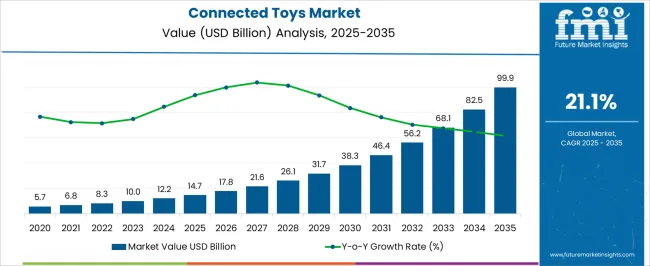
| Metric | Value |
|---|---|
| Connected Toys Market Estimated Value in (2025 E) | USD 14.7 billion |
| Connected Toys Market Forecast Value in (2035 F) | USD 99.9 billion |
| Forecast CAGR (2025 to 2035) | 21.1% |
The connected toys market is experiencing robust growth due to the fusion of interactive hardware with digital ecosystems that enhance learning, creativity, and engagement among children. As consumer preferences shift towards educational entertainment, connected toys that support STEM-based learning and real-time feedback have gained significant traction.
The widespread adoption of mobile devices and home automation systems has further enabled seamless integration of toys with smartphones, tablets, and voice assistants. Manufacturers are increasingly focusing on dynamic content updates, interactive storytelling, and AI-driven personalization to cater to the evolving needs of tech-savvy children and their caregivers.
Advancements in wireless communication protocols, low-power connectivity modules, and data security frameworks have strengthened the appeal of smart toys in both home and classroom environments Over the coming years, demand is expected to rise steadily as connectivity, user interface flexibility, and multi-sensory interactions become foundational features in toy design and distribution strategies.
The connected toys market is segmented by age group, interfacing device, technology, distribution channel, type, application, and geographic regions. By age group, the connected toys market is divided into 6-8 years, 0-5 years, 9-12 years, and Teenagers (13-19 years). In terms of the interfacing devices of the connected toys market, it is classified into Smartphones, Tablets, Consoles & PCs, and Wearables.
Based on technology, the connected toys market is segmented into Bluetooth, Wi-Fi, Radio Frequency Identification (RFID) or Near Field Communication (NFC), Artificial Intelligence (AI), and Augmented Reality (AR) and Virtual Reality (VR). By distribution channel, the connected toys market is segmented into Online Retail, Offline Retail, Specialty Stores, and Direct Sales.
By type, the connected toys market is segmented into robotics and programmable toys, App-Connected Toys, Voice-Activated Toys, Screenless Connected Toys, Smart Toys with Wearable Integration, and Smart Action Figures and Dolls. By application, the connected toys market is segmented into Educational, Entertainment, Fitness and Health, and Security and Monitoring. Regionally, the connected toys industry is classified into North America, Latin America, Western Europe, Eastern Europe, Balkan & Baltic Countries, Russia & Belarus, Central Asia, East Asia, South Asia & Pacific, and the Middle East & Africa.
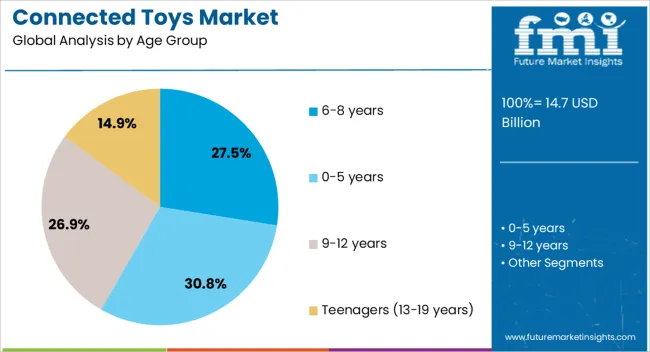
The 6 to 8 years age group segment is projected to account for 27.5% of the connected toys market revenue share in 2025, reflecting its pivotal role in driving market growth. This age range represents a critical developmental stage where cognitive skills, problem-solving abilities, and early learning concepts are actively nurtured through play. Connected toys tailored for this segment often incorporate structured educational content, voice recognition, and interactive modules that encourage logical reasoning and language development.
The demand for toys in this age group has been supported by rising parental focus on experiential learning tools and screen-free engagement. Devices designed for this demographic have increasingly integrated with classroom curricula and at-home learning platforms, further enhancing their appeal.
The incorporation of gamified learning models, customizable user profiles, and safety controls has positioned this age group as a key consumer base. As digital literacy initiatives expand, this segment is expected to retain its stronghold in the connected toy ecosystem.

Smartphones as an interfacing device are estimated to hold 32.4% of the connected toys market revenue share in 2025, positioning them as the most utilized connectivity medium. Their dominance stems from the ubiquity of mobile devices among both parents and children, enabling seamless control, content management, and interaction with connected toys.
Applications designed for smartphones have facilitated remote control functionalities, cloud-based content syncing, and real-time feedback mechanisms, making them essential for both entertainment and educational experiences. The integration of secure app ecosystems, multilingual support, and child protection features has encouraged widespread adoption across households.
Additionally, the rise of subscription-based educational platforms and content personalization engines has further enhanced the utility of smartphones in toy interfacing. The convenience of using existing mobile infrastructure, combined with lower barriers to entry for consumers, has made smartphones a cost-effective and flexible option, solidifying their role as the preferred bridge between children and connected toy experiences.
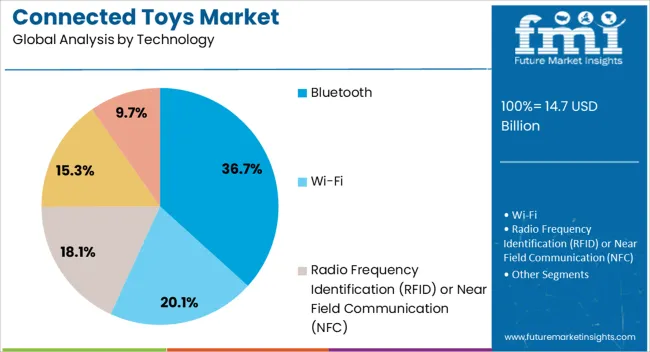
The Bluetooth segment is projected to capture 36.7% of the connected toys market revenue share in 2025, making it the most adopted technology type. Its widespread use is being driven by its low power consumption, reliable short-range communication capabilities, and compatibility with a broad range of smart devices. Bluetooth-enabled connected toys allow for seamless pairing with smartphones, tablets, and other interactive platforms, offering enhanced responsiveness and real-time interaction.
The preference for Bluetooth connectivity has been bolstered by its minimal setup requirements, stable performance in indoor environments, and ability to function without internet dependence, which addresses safety and privacy concerns. Manufacturers have also leveraged Bluetooth Low Energy (BLE) technology to extend battery life and enable continuous engagement without frequent charging.
The ability to support firmware updates, multi-device connectivity, and safe offline usage has contributed to the segment's popularity. As user demand continues to prioritize ease of use and secure connectivity, Bluetooth is expected to remain central to the technological backbone of connected toys.
The connected toys market is driven by a growing demand for interactive, educational play experiences, with opportunities emerging in the edutainment segment. Trends such as personalization and AI integration are reshaping the market, leading to more dynamic and custom play experiences. However, privacy concerns and regulatory challenges are significant restraints that could hinder growth. By 2025, addressing these challenges while capitalizing on personalization opportunities and advancing smart toy integration will be key to driving the market forward.
The connected toys market is primarily driven by increasing demand for interactive, smart play experiences. Parents and children are seeking more engaging, educational, and entertaining toys that provide both fun and learning. These toys, which often integrate with apps and online platforms, have gained popularity as they provide dynamic experiences. By 2025, the market is expected to grow significantly as connected toys become more prevalent in households, capitalizing on growing interest in immersive and interactive play experiences.
There is an emerging opportunity in the integration of connected toys with educational content, fueling the growth of the edutainment segment. Connected toys offer a unique way to combine entertainment with educational development, fostering skills such as problem-solving and critical thinking in children. The expanding demand for smart toys that can be linked to tablets, smartphones, and cloud-based platforms presents a robust opportunity for manufacturers. By 2025, these opportunities will likely lead to increased investments in the connected toys segment, particularly in the edutainment space.
Personalization is a major trend shaping the connected toys market, with manufacturers leveraging artificial intelligence (AI) to create more engaging experiences. AI-powered toys can adapt to a child’s learning pace and interests, offering personalized interactions and dynamic learning modules. As demand for more interactive, custom experiences increases, companies are focusing on developing toys that evolve with a child’s developmental stage. By 2025, AI integration will likely lead to more sophisticated connected toys, offering deeply personalized and evolving experiences.
One of the major restraints in the connected toys market is the growing concern over privacy and data security. As connected toys often involve internet access and the collection of data from children, there are significant concerns about safeguarding sensitive information. Strict data protection regulations and concerns over the ethical implications of children’s data usage are restraining market growth. By 2025, the industry will need to address these challenges by complying with regulations such as GDPR and ensuring the privacy of users, while still providing high-quality interactive experiences.
| Countries | CAGR |
|---|---|
| China | 28.5% |
| India | 26.4% |
| Germany | 24.3% |
| France | 22.2% |
| UK | 20.0% |
| USA | 17.9% |
| Brazil | 15.8% |
The global connected toys market is projected to grow at a 21.1% CAGR from 2025 to 2035. China leads with a growth rate of 28.5%, followed by India at 26.4%, and France at 22.2%. The United Kingdom records a growth rate of 20%, while the United States shows the slowest growth at 17.9%. These varying growth rates are driven by increasing demand for smart toys in the education, entertainment, and gaming sectors, combined with growing interest in interactive and connected play experiences. Emerging markets like China and India are experiencing higher growth due to rapid urbanization, increasing disposable incomes, and rising consumer demand for innovative and educational toys, while more mature markets like the USA and the UK see steady growth driven by advancements in technology, gaming trends, and increased adoption of connected devices in toys. This report includes insights on 40+ countries; the top markets are shown here for reference.
The connected toys market in China is growing rapidly, with a projected CAGR of 28.5%. China’s expanding consumer market, increasing disposable incomes, and growing demand for interactive and educational toys are key drivers of market growth. The country’s rising focus on digitalization, coupled with government policies supporting technological innovation and the growth of the gaming and entertainment industries, accelerates the adoption of connected toys. Additionally, China’s rapidly expanding e-commerce sector and increased investments in smart technology products contribute to the widespread availability and adoption of connected toys. The rising interest in STEM education, coupled with increasing participation in gaming, further boosts the demand for connected toys.
The connected toys market in India is projected to grow at a CAGR of 26.4%. India’s rising middle class, coupled with increasing consumer spending on educational and interactive toys, is driving market growth. The country’s growing urbanization, increasing interest in digital play experiences, and expanding e-commerce sector further contribute to the demand for connected toys. Additionally, India’s increasing focus on technology and digital learning, along with rising participation in gaming and entertainment, accelerates the adoption of connected toys. Government initiatives promoting innovation in education and the rise in smartphone penetration are also driving the growth of smart toys in the Indian market.
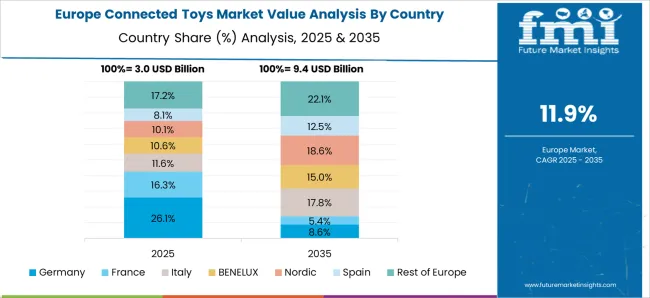
The connected toys market in France is projected to grow at a CAGR of 22.2%. France’s increasing demand for interactive and educational toys, particularly in the digital play and gaming sectors, is driving steady market growth. The country’s growing interest in smart toys for enhancing children's learning experiences continues to contribute to market expansion. Additionally, France’s strong focus on technological advancements and educational reforms, combined with rising disposable incomes and increased interest in online shopping, further accelerates the demand for connected toys. The country’s increasing adoption of smart home devices and the rise in mobile gaming continue to support the adoption of connected toys in both residential and commercial sectors.
The connected toys market in the United Kingdom is projected to grow at a CAGR of 20%. The UK’s growing interest in interactive toys, combined with increasing consumer demand for educational and smart play experiences, continues to drive steady market growth. The country’s focus on digital learning and advancements in mobile gaming further accelerate the adoption of connected toys. Additionally, the rise in e-commerce sales, coupled with increasing disposable incomes and consumer interest in high-tech toys, supports the growing demand for connected toys in the UK The UK’s focus on innovation in both technology and education continues to boost market expansion.
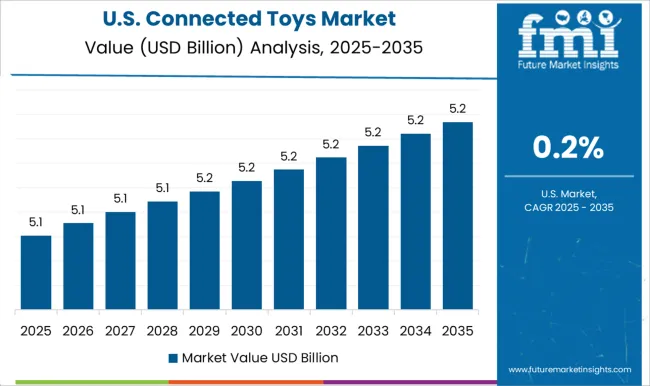
The connected toys market in the United States is expected to grow at a CAGR of 17.9%. The USA market remains steady, driven by the increasing demand for interactive and smart toys, particularly in the gaming and educational sectors. The country’s growing interest in STEM education, combined with the increasing focus on mobile gaming and digital play, continues to boost the adoption of connected toys. Additionally, the USA market benefits from high disposable incomes, widespread internet connectivity, and a strong e-commerce sector, contributing to the growth of the connected toys market. Increasing consumer preference for high-quality, tech-driven play experiences further accelerates market expansion.
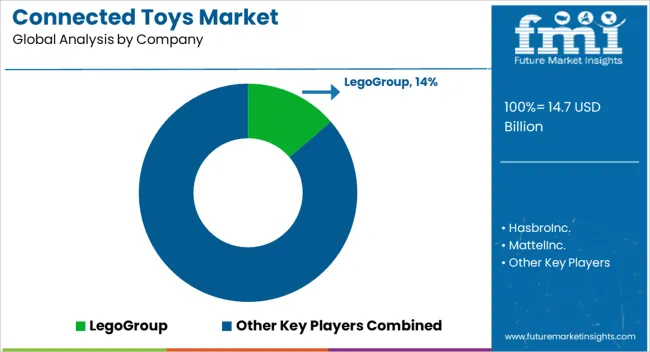
The connected toys market is dominated by Lego Group, which leads with its innovative connected toy solutions that combine physical play with digital experiences, enhancing creativity and learning for children. Lego's dominance is supported by its strong brand recognition, extensive product range, and integration of smart technology into its toy offerings, such as interactive robots and augmented reality features.
Key players such as Mattel Inc., Hasbro Inc., and Fisher-Price Inc. maintain significant market shares by offering a wide range of connected toys that blend entertainment and education, fostering child development through digital and physical play. These companies focus on enhancing user interactivity, integrating learning apps, and providing safe, age-appropriate technology. Emerging players like VTech Electronics North America LLC, LeapFrog Enterprises Inc., and Sphero Inc. are expanding their market presence by offering specialized connected toys that focus on educational content, coding, and STEM learning. Their strategies include improving the customization of learning experiences, enhancing safety features, and offering affordable tech-based toys that meet the needs of tech-savvy parents. Market growth is driven by the increasing adoption of smart toys, rising demand for educational tools, and the growing interest in interactive, screen-free entertainment for children. Innovations in AI-powered toys, voice recognition, and IoT integration are expected to continue shaping the competitive landscape and drive further growth in the global connected toys market.
| Item | Value |
|---|---|
| Quantitative Units | USD 14.7 Billion |
| Age Group | 6-8 years, 0-5 years, 9-12 years, and Teenagers (13-19 years) |
| Interfacing Device | Smartphones, Tablets, Consoles & PCs, and Wearables |
| Technology | Bluetooth, Wi-Fi, Radio Frequency Identification (RFID) or Near Field Communication (NFC), Artificial Intelligence (AI), and Augmented Reality (AR) and Virtual Reality (VR) |
| Distribution Channel | Online Retail, Offline Retail, Specialty Stores, and Direct Sales |
| Type | Robotics & Programmable Toys, App-Connected Toys, Voice-Activated Toys, Screenless Connected Toys, Smart Toys with Wearable Integration, and Smart Action Figures and Dolls |
| Application | Educational, Entertainment, Fitness and Health, and Security and Monitoring |
| Regions Covered | North America, Europe, Asia-Pacific, Latin America, Middle East & Africa |
| Country Covered | United States, Canada, Germany, France, United Kingdom, China, Japan, India, Brazil, South Africa |
| Key Companies Profiled | LegoGroup, HasbroInc., MattelInc., NintendoCo.Ltd., Fisher-PriceInc., VTechElectronicsNorthAmericaLLC., LeapFrogEnterprisesInc., TomyCompanyLtd., KNEXIndustriesInc., SpheroInc., JabilInc., KidsIIInc., Melissa&Doug, LittleTikes, and TruKidsInc. |
| Additional Attributes | Dollar sales by toy type and application, demand dynamics across educational, entertainment, and health sectors, regional trends in connected toy adoption, innovation in IoT integration and interactive features, impact of regulatory standards on data security and child safety, and emerging use cases in personalized learning and smart play experiences. |
The global connected toys market is estimated to be valued at USD 14.7 billion in 2025.
The market size for the connected toys market is projected to reach USD 99.9 billion by 2035.
The connected toys market is expected to grow at a 21.1% CAGR between 2025 and 2035.
The key product types in connected toys market are 6-8 years, 0-5 years, 9-12 years and teenagers (13-19 years).
In terms of interfacing device, smartphones segment to command 32.4% share in the connected toys market in 2025.






Our Research Products

The "Full Research Suite" delivers actionable market intel, deep dives on markets or technologies, so clients act faster, cut risk, and unlock growth.

The Leaderboard benchmarks and ranks top vendors, classifying them as Established Leaders, Leading Challengers, or Disruptors & Challengers.

Locates where complements amplify value and substitutes erode it, forecasting net impact by horizon

We deliver granular, decision-grade intel: market sizing, 5-year forecasts, pricing, adoption, usage, revenue, and operational KPIs—plus competitor tracking, regulation, and value chains—across 60 countries broadly.

Spot the shifts before they hit your P&L. We track inflection points, adoption curves, pricing moves, and ecosystem plays to show where demand is heading, why it is changing, and what to do next across high-growth markets and disruptive tech

Real-time reads of user behavior. We track shifting priorities, perceptions of today’s and next-gen services, and provider experience, then pace how fast tech moves from trial to adoption, blending buyer, consumer, and channel inputs with social signals (#WhySwitch, #UX).

Partner with our analyst team to build a custom report designed around your business priorities. From analysing market trends to assessing competitors or crafting bespoke datasets, we tailor insights to your needs.
Supplier Intelligence
Discovery & Profiling
Capacity & Footprint
Performance & Risk
Compliance & Governance
Commercial Readiness
Who Supplies Whom
Scorecards & Shortlists
Playbooks & Docs
Category Intelligence
Definition & Scope
Demand & Use Cases
Cost Drivers
Market Structure
Supply Chain Map
Trade & Policy
Operating Norms
Deliverables
Buyer Intelligence
Account Basics
Spend & Scope
Procurement Model
Vendor Requirements
Terms & Policies
Entry Strategy
Pain Points & Triggers
Outputs
Pricing Analysis
Benchmarks
Trends
Should-Cost
Indexation
Landed Cost
Commercial Terms
Deliverables
Brand Analysis
Positioning & Value Prop
Share & Presence
Customer Evidence
Go-to-Market
Digital & Reputation
Compliance & Trust
KPIs & Gaps
Outputs
Full Research Suite comprises of:
Market outlook & trends analysis
Interviews & case studies
Strategic recommendations
Vendor profiles & capabilities analysis
5-year forecasts
8 regions and 60+ country-level data splits
Market segment data splits
12 months of continuous data updates
DELIVERED AS:
PDF EXCEL ONLINE
Connected Sensors Market Size and Share Forecast Outlook 2025 to 2035
Connected Diagnostics Market Size and Share Forecast Outlook 2025 to 2035
Connected RHM (Remote Healthcare Monitoring) Market Size and Share Forecast Outlook 2025 to 2035
Connected Aircraft Market Size and Share Forecast Outlook 2025 to 2035
Connected Packaging Market Size and Share Forecast Outlook 2025 to 2035
Connected Living Room Market Size and Share Forecast Outlook 2025 to 2035
Connected Vehicle Technology Market Size and Share Forecast Outlook 2025 to 2035
Connected Tire Market Size and Share Forecast Outlook 2025 to 2035
Connected Logistics Market Growth - Trends, Demand & Innovations 2025 to 2035
Connected Drug Delivery Devices Market Size and Share Forecast Outlook 2025 to 2035
Connected Home Surveillance Devices Market Growth - Trends & Forecast 2025-2035
Connected Game Console Market Analysis by Product Type, Application, and Region through 2035
Understanding Connected TV Market Share & Growth Trends
Connected TV’s Market Outlook 2025 to 2035
Connected Healthcare Market
Connected Car Market Growth – Trends & Forecast 2024-2034
AI-Driven Smart Home Appliances – Enhancing Home Automation
Connected Lighting Platform Market
Connected Enterprise Video Surveillance Solutions Market
Connected Energy Market

Thank you!
You will receive an email from our Business Development Manager. Please be sure to check your SPAM/JUNK folder too.
Chat With
MaRIA